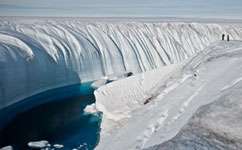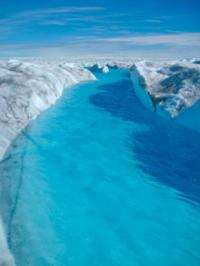Tracers reveal hidden rivers beneath ice-sheet

Artificial gas tracers pumped into water at the surface of the Greenland ice sheet have revealed a hidden network of rivers flowing beneath it.
The study, published in Nature Geoscience, may give clues about the ways in which Greenland and Antarctica's enormous ice masses are reacting to our changing climate, and tell us how they might contribute to sea-level rise.
Scientists had used tracers to track the flow of water beneath mountain glaciers before, but this is the first time that they have been able to look directly at what's happening at the base of one of these larger bodies of ice.
'Before we started this project five years ago, nobody really knew if and how water flowed at the bed of ice sheets,' says Professor Jemma Wadham of the University of Bristol, one of the study's authors.
'Since then, a number of studies have inferred what's going on at the bed from what's happening at the surface, but this is the first time we've been able to more directly see what's going on down there.'
A team stationed up to 60km inland pumped a fluorescent liquid and a traceable gas into water at the surface, occasionally using a garden hose to get the job done.

Another group of scientists then monitored streams flowing out at the ice-sheet margin, waiting patiently for the tracers to appear.
'It's quite a tense time - you're sort of sampling in the dark because you don't know for sure where and when the tracers will come out,' explains Wadham.
The speed at which the water came through suggested that it had been carried in fast-flowing rivers beneath the ice.
This could have important consequences for understanding the overall stability of the ice sheet, explains Wadham.
'If water flows in a thin film over much of the ice sheet bed, then it acts as an effective lubricant and the ice can slide more easily,' she says.
'If water travels in narrow channels, then it can move through very quickly and you don't get the same extent of lubricating effect.'
If increased surface melting causes water to drain through the ice more quickly, this could mean that ice sheets are more resilient to climate change than first feared.
But scientists are keen to stress that the relationships between surface melting, the flow of water at the base of the ice, and the overall stability of ice sheet remain uncertain.
Work now begins on incorporating this work, which was largely funded by NERC grants, into computer forecasts of ice-sheet responses to our warming climate.
More information: Chandler, D. et al. Evoloution of the subglacial drainage system beneath the Greenland Ice Sheet revealed by tracers, Nature Geoscience, 2013, doi: 10.1038/NGEO1737
Journal information: Nature Geoscience
Provided by PlanetEarth Online
This story is republished courtesy of Planet Earth online, a free, companion website to the award-winning magazine Planet Earth published and funded by the Natural Environment Research Council (NERC).



















